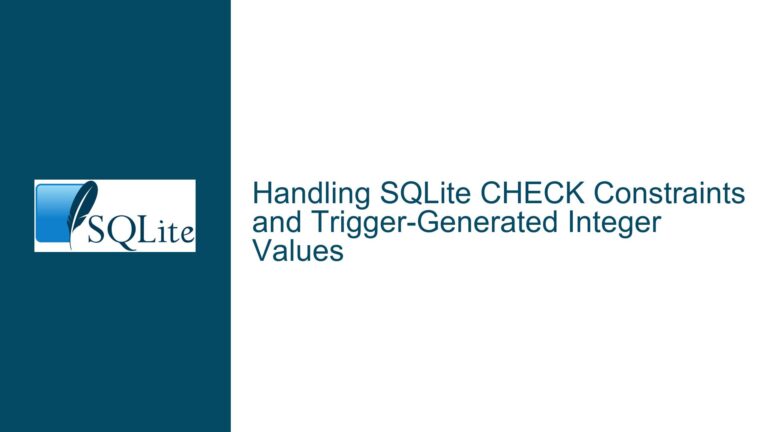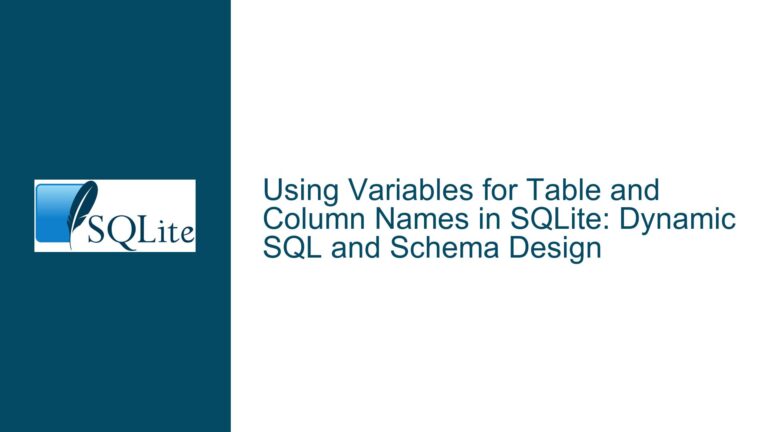Efficiently Tracking and Managing Row Order in SQLite Using JSON Arrays and Linked Lists
Understanding the Need for Ordered Row Management in SQLite
In many database applications, the need to maintain a specific order of rows is a common requirement. This is particularly true in scenarios where the data represents a sequence or hierarchy, such as document editing, task management, or any system where the order of elements is critical to the functionality. SQLite, being a lightweight and versatile database, does not inherently support ordered rows. Instead, it treats tables as unordered collections of rows. This presents a challenge when the application logic depends on the order of rows, as is the case in the scenario described.
The core issue revolves around efficiently managing the order of rows in a table where the order is dynamic and subject to frequent changes due to user interactions. The initial approach involves using a JSON array to store the order of keys, which are then used to query the rows in the desired sequence. However, this approach raises concerns about performance and scalability, especially when the number of rows grows to tens of thousands. Additionally, the lack of native support for inserting elements into the middle of a JSON array in SQLite complicates the process of maintaining the order.
Exploring the Limitations and Alternatives of JSON Arrays for Row Order Management
The use of JSON arrays to manage row order in SQLite is a pragmatic solution that leverages SQLite’s JSON1 extension. This extension provides functions to manipulate JSON data, making it possible to store and query ordered lists within a single column. However, this approach has several limitations that become apparent as the dataset grows.
One of the primary limitations is the performance overhead associated with parsing and manipulating large JSON arrays. When the order_keys array contains thousands of elements, each operation to insert, remove, or reorder keys requires parsing the entire JSON string, modifying it, and then writing it back to the database. This can lead to significant performance degradation, especially in scenarios where the order is frequently updated.
Another limitation is the lack of direct support for inserting elements into the middle of a JSON array. While SQLite’s JSON1 extension provides functions like json_insert, these functions are designed to append elements rather than insert them at arbitrary positions. This limitation necessitates the use of custom application logic or user-defined functions to achieve the desired functionality, which adds complexity to the implementation.
Given these limitations, it is worth exploring alternative approaches to managing row order in SQLite. One such alternative is the use of a linked list structure, where each row contains references to its previous and next rows. This approach eliminates the need for a centralized JSON array and allows for more efficient updates to the row order. However, it also introduces its own set of challenges, such as increased complexity in querying the ordered rows and managing the integrity of the linked list.
Implementing and Optimizing a Linked List Structure for Row Order Management
The linked list approach to managing row order in SQLite involves adding two additional columns to the table: previous_key and next_key. These columns store the keys of the previous and next rows in the sequence, effectively creating a doubly linked list. This structure allows for efficient insertion and removal of rows at any position in the sequence, as only the affected rows need to be updated.
To implement this approach, the table schema would be modified as follows:
CREATE TABLE pt_pointers (
doc_id INTEGER,
key INTEGER,
buffer_id INTEGER,
char_start INTEGER,
char_length INTEGER,
previous_key INTEGER,
next_key INTEGER,
PRIMARY KEY (doc_id, key)
);
In this schema, the previous_key and next_key columns are used to maintain the order of rows for each doc_id. When a new row is inserted, the previous_key and next_key values of the surrounding rows are updated to reflect the new order. Similarly, when a row is removed, the previous_key and next_key values of the adjacent rows are updated to bypass the removed row.
Querying the rows in the correct order requires traversing the linked list. This can be achieved using a recursive common table expression (CTE) in SQLite. The following query demonstrates how to retrieve the rows in order for a specific doc_id:
WITH RECURSIVE ordered_rows AS (
SELECT
key,
buffer_id,
char_start,
char_length
FROM
pt_pointers
WHERE
doc_id = 1 AND previous_key IS NULL
UNION ALL
SELECT
p.key,
p.buffer_id,
p.char_start,
p.char_length
FROM
pt_pointers p
INNER JOIN
ordered_rows o ON p.previous_key = o.key
WHERE
p.doc_id = 1
)
SELECT * FROM ordered_rows;
This query starts with the row that has no previous_key (i.e., the first row in the sequence) and recursively joins the next row in the sequence until all rows are retrieved. While this approach is more complex than using a JSON array, it offers better performance for large datasets and more efficient updates to the row order.
However, the linked list approach is not without its challenges. One of the main challenges is maintaining the integrity of the linked list, especially in scenarios where rows are frequently inserted, removed, or reordered. Care must be taken to ensure that the previous_key and next_key values are always correctly updated to avoid breaking the sequence. Additionally, querying the ordered rows requires more complex SQL queries, which can be harder to write and maintain.
Balancing Performance and Complexity: Choosing the Right Approach for Your Application
When deciding between using a JSON array or a linked list to manage row order in SQLite, it is important to consider the specific requirements and constraints of your application. Both approaches have their advantages and disadvantages, and the choice ultimately depends on factors such as the size of the dataset, the frequency of updates to the row order, and the complexity of the queries required to retrieve the ordered rows.
For smaller datasets or applications where the row order is relatively static, using a JSON array may be a simpler and more straightforward solution. The JSON1 extension provides sufficient functionality to manage the order, and the performance overhead may be acceptable for smaller datasets. However, as the dataset grows or the frequency of updates increases, the limitations of this approach become more pronounced, and the linked list approach may offer better performance and scalability.
On the other hand, the linked list approach is more complex to implement and maintain, but it offers better performance for large datasets and frequent updates. The ability to efficiently insert, remove, and reorder rows without needing to parse and modify a large JSON array can lead to significant performance improvements. However, this approach requires careful management of the linked list structure and more complex queries to retrieve the ordered rows.
In conclusion, the choice between using a JSON array or a linked list to manage row order in SQLite depends on the specific needs of your application. By carefully considering the trade-offs between performance and complexity, you can choose the approach that best meets your requirements and ensures efficient and reliable management of row order in your SQLite database.





